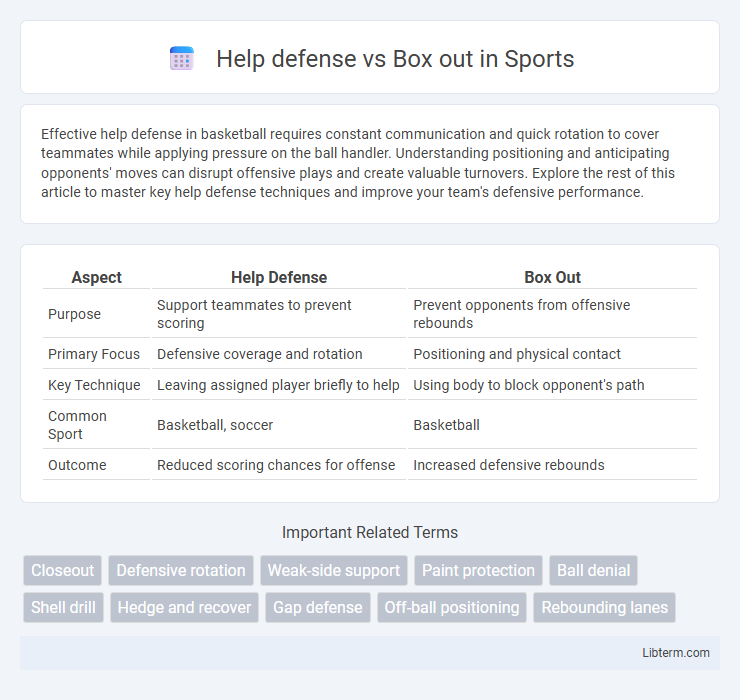Effective help defense in basketball requires constant communication and quick rotation to cover teammates while applying pressure on the ball handler. Understanding positioning and anticipating opponents' moves can disrupt offensive plays and create valuable turnovers. Explore the rest of this article to master key help defense techniques and improve your team's defensive performance.
Table of Comparison
| Aspect | Help Defense | Box Out |
|---|---|---|
| Purpose | Support teammates to prevent scoring | Prevent opponents from offensive rebounds |
| Primary Focus | Defensive coverage and rotation | Positioning and physical contact |
| Key Technique | Leaving assigned player briefly to help | Using body to block opponent's path |
| Common Sport | Basketball, soccer | Basketball |
| Outcome | Reduced scoring chances for offense | Increased defensive rebounds |
Understanding Help Defense in Basketball
Help defense in basketball involves a defender temporarily leaving their assigned player to assist a teammate defending against an offensive threat, focusing on team coordination and spatial awareness. Understanding help defense requires recognizing angles, timing rotations, and communicating effectively to prevent easy scoring opportunities while maintaining readiness to recover and contest shots. Mastering help defense improves overall team defense by limiting penetration and forcing contested perimeter shots, complementing box out strategies during rebounding.
The Fundamentals of Boxing Out
Effective boxing out in basketball requires establishing a strong, wide base and maintaining a low center of gravity to control the space between the opponent and the basket. Proper hand placement involves extending arms to create physical separation without fouling, enabling the defender to anticipate rebounds accurately. Mastering these fundamentals enhances help defense by ensuring secure positioning and effective contesting of shots or passes.
Key Differences: Help Defense vs Box Out
Help defense prioritizes providing defensive support by leaving a player's assigned opponent temporarily to assist teammates in contesting shots or preventing drives, relying on quick rotations and communication. Box out emphasizes positioning and physical contact to secure rebounding opportunities by establishing space between the opponent and the basket immediately after a shot attempt. The key difference lies in help defense focusing on team-based coverage and preventing scoring, while box out concentrates on individual positioning to control rebounds.
Importance of Communication on Defense
Effective help defense and box out strategies rely heavily on clear communication among teammates to prevent defensive breakdowns and secure rebounds. Vocal coordination ensures players can quickly identify offensive threats, provide timely help, and execute proper boxing out techniques to limit second-chance opportunities. Consistent communication enhances defensive positioning and heightens overall team awareness, critical factors in controlling the paint and maintaining defensive intensity.
Positioning: The Foundation of Both Skills
Effective help defense and boxing out rely heavily on precise positioning to control the opponent's movement and secure rebounds. Maintaining a strong defensive stance between the basket and the offensive player enables quick rotations for help defense and optimal leverage during box outs. Consistent awareness of spatial relationships ensures defenders can anticipate plays, reduce scoring opportunities, and dominate in rebounding battles.
When to Prioritize Help Defense
Prioritize help defense when an opponent drives aggressively toward the basket or faces a mismatch against a weaker defender, allowing your team to cut off scoring opportunities effectively. It is crucial to rotate quickly and communicate on defense during pick-and-roll situations where the ball handler has an advantage. When a teammate is out of position or beaten off the dribble, help defense limits easy baskets and forces opponents into contested shots or turnovers.
Effective Box Out Techniques
Effective box out techniques involve establishing a strong, wide base with bent knees and maintaining a low center of gravity to prevent opponents from gaining easy rebounds. Proper timing is crucial, as players must anticipate the shot and quickly position themselves between the basket and their defender, using their hips and forearms to create a physical barrier without fouling. Combining these techniques with active awareness during help defense enhances team rebounding efficiency and limits second-chance scoring opportunities.
Common Mistakes: Help Defense and Box Out
Common mistakes in help defense include overcommitting away from the man, which leaves the original defender vulnerable and creates easy scoring opportunities for opponents. In box out techniques, players often fail to establish a wide, balanced stance and maintain contact, resulting in missed rebounds and second-chance points. Mastering spatial awareness and positioning is crucial to effectively support teammates and control the paint on defensive plays.
Training Drills: Improving Both Skills
Training drills combining help defense and box out techniques enhance defensive awareness and rebounding effectiveness by simulating game scenarios where defenders must quickly switch roles. Emphasizing footwork, communication, and positioning through partner shadow drills and controlled rebounding contests sharpens players' ability to provide timely help defense while boxing out opponents. Integrating reaction-based exercises improves defensive agility, enabling players to transition efficiently between contesting shots and securing rebounds.
Integrating Help Defense and Box Out in Game Strategy
Integrating help defense and box out in game strategy enhances team defense by preventing easy second-chance points and forcing opponents into difficult shot opportunities. Effective communication and timing enable defenders to rotate quickly for help defense while teammates secure rebounds through box out techniques, creating a cohesive defensive unit. This synergy maximizes rebounding control and limits opponent scoring chances, crucial for maintaining defensive intensity throughout the game.
Help defense Infographic

 libterm.com
libterm.com